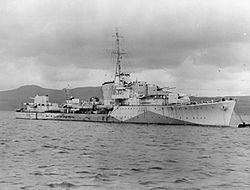Battle of the Ligurian Sea facts for kids
Quick facts for kids Battle of the Ligurian Sea |
|||||||
|---|---|---|---|---|---|---|---|
| Part of the Battle of the Mediterranean of World War II | |||||||
 British destroyer HMS Meteor |
|||||||
|
|||||||
| Belligerents | |||||||
| Commanders and leaders | |||||||
| Strength | |||||||
| 2 destroyers | 1 destroyer 2 torpedo boats |
||||||
| Casualties and losses | |||||||
| 1 destroyer damaged | 60 killed 244 captured 2 torpedo boats sunk 1 destroyer damaged |
||||||
The Battle of the Ligurian Sea was a naval battle during World War II. It happened on March 18, 1945, in the Ligurian Sea, which is part of the Mediterranean Sea.
In this battle, two British destroyers, HMS Lookout and Meteor, fought against a German group of ships. The German group had two torpedo boats and one destroyer. The German ships were trying to secretly lay mines at night. The British ships stopped them. The British won the battle, sinking two German ships and badly damaging the third. This was the last time German surface ships fought in the war.
Contents
Why the Battle Happened
Moving Troops in Wartime
In early 1945, World War II was still going on. The Allies (like Britain, France, and the US) decided to move many soldiers and air force units. These troops were in Italy and needed to go to France and Belgium. This big move was called Operation Goldflake.
Protecting the Ships
To move these troops safely, many ships were needed. These troopships needed protection from enemy attacks. British, French, and US warships were used as escorts. Airplanes also helped protect the ships from above.
Before the Fight Started
German Mine-Laying Mission
On the night of March 17, 1945, three German ships left Genoa. These ships were the last ones still working in the German 10th Flotilla. Their mission was to secretly lay mines in the sea.
The German ships were two torpedo boats, TA24 and TA29, and one destroyer, TA32. They laid many mines in different areas.
Allied Ships on Patrol
While the German ships were laying mines, Allied ships were patrolling nearby. Four destroyers were in the area. Two were French, and two were British: HMS Lookout and Meteor.
Germans Spotted by Radar
A special radar station on the coast of Italy, at Livorno, spotted the German ships. This radar report was sent to the Allied destroyers. The British ships were told to go and stop the German ships.
The Battle Begins
Lookout Finds the Enemy
At 3:00 AM on March 18, the British destroyer Lookout found the German ships using its radar. The German ships were sailing north. Lookout quickly moved in and started firing its guns from about 5,000 yards away.
Surprise Attack
The German ships were surprised by the sudden attack. Lookout's guns, guided by radar, quickly hit two German ships, TA24 and TA29. Lookout also launched torpedoes.
TA29 Sinks
One of the German ships, TA29, was badly damaged and fell behind. Lookout focused its attack on TA29. It circled the damaged ship, firing its six 4.7-inch guns continuously. TA29 tried to fight back, but after more than 40 hits, it caught fire and sank. Only 20 German sailors from TA29 were lost.
Meteor Joins the Fight
While Lookout was fighting TA29, the other British destroyer, Meteor, found the remaining two German ships. Meteor opened fire from about 8,000 yards away. It hit TA24 almost right away.
TA24 is Destroyed
Meteor then launched torpedoes. One of them hit TA24, causing a huge explosion. TA24 sank very quickly, losing 30 sailors in just 13 minutes.
What Happened After
The Battle of the Ligurian Sea was very important. It was the last time German surface ships fought in World War II. After this battle, the German navy could no longer carry out big attacks in the Ligurian Sea or anywhere else in the Mediterranean. It was also the last major naval battle for the British in this part of the war.
Escape and Capture
The third German ship, TA32, was damaged but managed to escape. However, its crew later sank it themselves in Genoa on April 25, 1945. The British destroyers rescued 244 German sailors from the sunken ships, including the German commander, Franz Burkart. These sailors were taken as prisoners.
A Decisive Victory
Experts say that the British destroyers achieved a "decisive result" in this battle. Their victory effectively ended the German navy's ability to operate in the deep waters of the Mediterranean.
Images for kids


